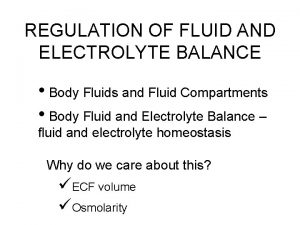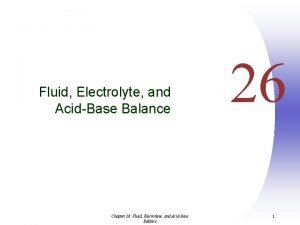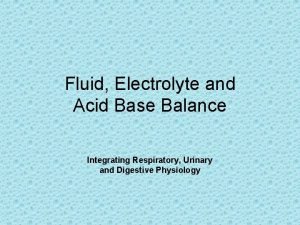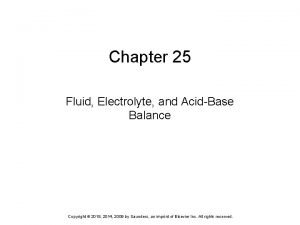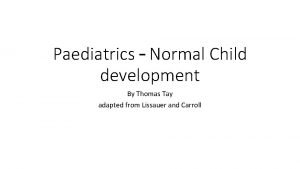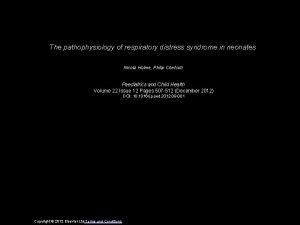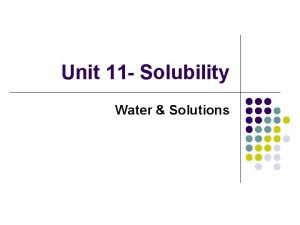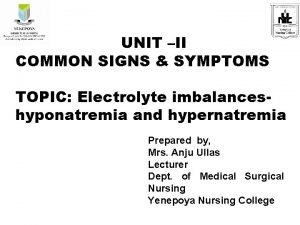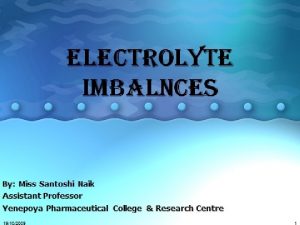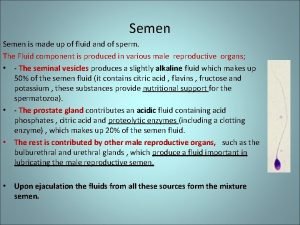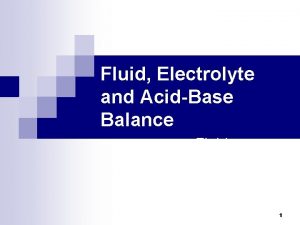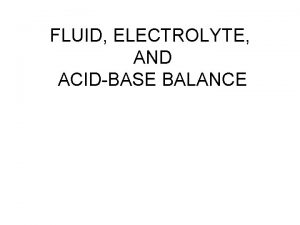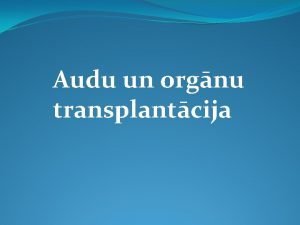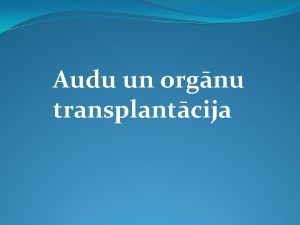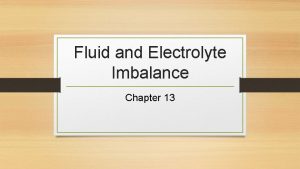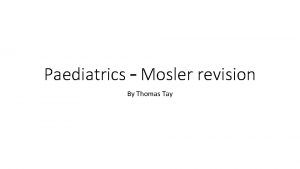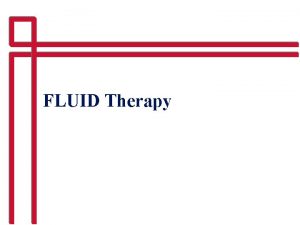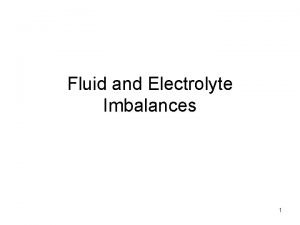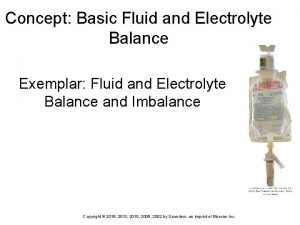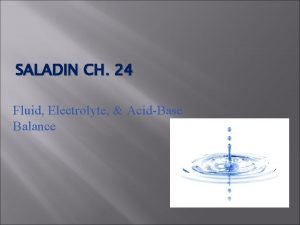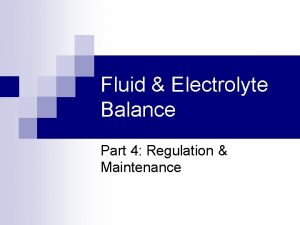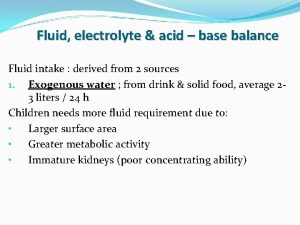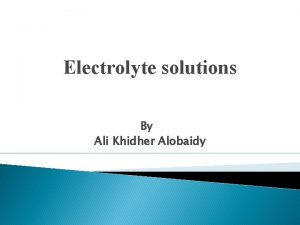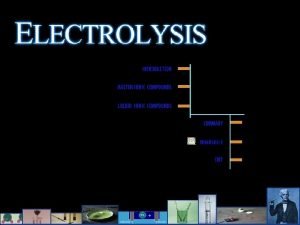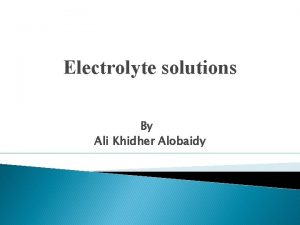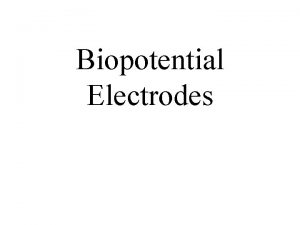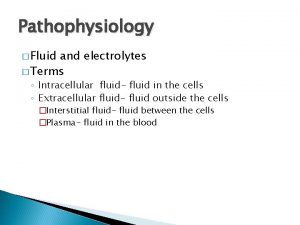FLUID AND ELECTROLYTE MANAGEMENT in paediatrics Dr Audu





























![Severe hyponatraemia • Serum [Na+] <121 m. Eq/L • Lethargy and seizures • Correct Severe hyponatraemia • Serum [Na+] <121 m. Eq/L • Lethargy and seizures • Correct](https://slidetodoc.com/presentation_image_h/0aab78e8aaecde3bebf5a4fa6803e913/image-30.jpg)





- Slides: 35

FLUID AND ELECTROLYTE MANAGEMENT in paediatrics Dr Audu Lamidi Isah Chief Consultant Peadiatrician © NITMED TUTORIALS

Objectives • Understand Normal Fluid and electrolyte distribution and homeostasis • Derangement in Fluid and electrolyte balance • Severity and types of dehydration • Fluid and electrolyte therapy in children

Introduction • Total body water (TBW) changes from birth up to the age of 1 year. • At birth TBW constitute 80% of total body weight and this slowly decreases to 60% at one year. • TBW in adult is about 60% of body weight • Baby loses weight (5 -10%) in the first week of life, mainly from body fluid.

Distribution of body Fluid • Body fluid is divided into 2 major compartments • Extracellular compartment 45% • Intracellular compartment 35% • Fluid intake is required regularly to maintain this body fluids.

Body fluid and electrolyte distribution • ECF (intravascular and interstitial) • Na+ is Principal ECF cation while Cl - and HCO 3 - are principal anions • Regulation of ECF is primarily related to Na balance; total body Na affects ECF vol • ICF: water within the cells. • Principal cation is K. and anion = HPO 4 -2 • ICF and ECF separated by cell membrane permeable to H 2 O but not to solutes

Osmolality • A measure of all solute particles per weight of solvent • Na, Cl, glucose, urea, ethanol • Calc. Osmolality = 2 x [Na+](m. Eq/L) + BUN(mg/d. L)/2. 8 + Glucose(mg/d. L)/18 • Normal osmolality= 280 -295 m. Osm/kg • At steady state- Osmolality of ICF= ECF

The need for fluids and electrolytes §Routinely: Fluids and electrolytes are required on daily basis to maintain optimal body functions §Therapeutically administered fluids become necessary in the following conditions: 1. Absence or diminished oral fluid intake (surgical or critically ill patients or patients with diminished drive for food) 2. Increased fluid losses- e. g. Patients with vomiting, diarrhoea, polyuria as in diabetic ketoacidosis, diabetes insipidus, etc

Goals of Body Fluid and Electrolyte Maintenance • Prevent dehydration • Prevent electrolyte disorders • Prevent ketoacidosis • Prevent protein degradation

Physiologic Fluid loss • Urine: 60% • Insensible losses: ∼ 35% (perspiration and respiration) • Stool: 5% • Maintenance fluid is constantly required to replace ongoing physiologic losses in order to preserve normal body homeostasis

Pathologic loss of fluid • Significant amount of fluid is lost (at least 5%) • May be mild moderate or severe • When severe, it may compromise tissue perfusion • It is important to be able to identify signs and define the level of dehydration in patients that have lost significant amount of fluid

Indications for Adjustments in Maintenance Water: ↑d fluid loss Transcutaneous • Radiant warmer • Phototherapy • Fever • Sweat • Burns Respiratory tract • Tachypnea • Tracheostomy GIT : Diarrhea, Emesis Nasogastric suction Renal: Polyuria Surgical: Surgical drains • 3 rd spacing intestinal obstruction • Omphalocele • Gastroschisis

Fluid therapy • Goal: To achieve Normal volume and electrolyte composition of body fluids • Consists of : Maintenance, Deficit and Ongoing losses. • Note that the body compensates for excess water intake by DIURESIS and that this mechanism may be inhibited by inappropriate ADH secretion in certain situations: critical illnesses such as Perinatal Asphyxia, peri-operatively. Cautious fluid therapy is required to prevent cerebral oedema.

Maintenance • Replacement of physiologic losses(sweat, urine, respiration, stools) to preserve homeostasis. • The volume may vary when there are changes in the clinical status of the patient. • Children need higher maintenance fluids than adults because of higher metabolic rate, higher body surface area: weight ratio and higher respiratory rate.

Maintenance fluid therapy contd • Holliday-Segar formula for calculating maintenance fluid: ØFirst 10 kg: 100 mls/kg/day (4 ml/kg/hr) ØSecond 10 kg: 50 mls/kg/day (2 ml/kg/hr) ØEvery kg thereafter: 20 mls/kg/day (1 ml/kg/hr)

Repletion (deficit) therapy • This refers to the correction of established losses to return the body to normal fluid and electrolyte status. • Usually due to diarrhea/vomiting, traumatic haemorrhage, or inadequate intake. • Requires an initial assessment: ØClinical signs correlate with degree of dehydration: mild, moderate, severe ØBiochemical tests type of dehydration

Clinical signs of dehydration

Types of Dehydration • Sodium is the most important electrolyte in defining type of dehydration • Isotonic (Na level 135 -145 mmol/L): This is the most commonly encountered type • Hypotonic/hyponatraemic <135 mmol/L • Hypernatraemic (Na >145 mmol/l): least commonly encountered but most difficult to identify because of the peculiar clinical signs.

Hypernatraemic dehydration • Signs predominantly CNS; Hypertonia, depressed sensorium, full/bulging AF in infants, convulsions, doughy abdomen • Hyper osmolality of ECF relative to ICF results in shift of fluid from ICF to ECF→ cellular dehydration • Common in neonates and young infants and may result from inadequate breastfeeding, excessive cutaneous fluid loss, use of improperly constituted BMS or ORS • Patients presenting with hypernatraemic dehydration are invariably severely dehydrated

Severity of dehydration/Fluid requirement

Mild to moderate dehydration • Oral rehydration is usually adequate • Available fluids contain calories (carbohydrate 140 mml/l), Sodium (45 mmol/l), Potassium (20 mmol/L) • Requires 50 -75 mls/Kg and this can be given over 4 -8 hours • Supervise administration and monitor closely

Severe dehydration • Fluid correction in severe dehydration is effected in phases: total deficit 100 mls/kg • Phase 1: Øto expand extravascular volume for adequate tissue perfusion. ØIsotonic solution is used (Normal saline or Ringers lactate) ØGive as 20 mls/kg over 1 hour. This may need to be repeated.

Severe dehydration contd • Phase 2: 1. Subtract phase 1 fluid from total deficit 2. Give ½ of what remains over 8 hours 3. This is added to 1/3 of the daily maintenance 4. Fluid type for phases 2 : 5% Dextrose in ½ N/Saline (. 45 Saline)

• Phase 3: 1. give 2 nd ½ over 16 hours 2. This is added to 2/3 of daily maintenance 3. Fluid type 4. 3%D in. 18 Saline 4. Add 20 -30 m. Eq/L of potassium (ensure patient has made urine before adding K+1 ) beginning from phase 2

Calculating fluid replacement in isotonic or hypotonic dehydration

Patient monitoring during IV rehydration

Hypernatraemic dehydration • Initial step as for severe dehydration for ECF expansion: 20 mls/kg over 1 hour • The remaining deficit fluid volume is added to the maintenance fluid volume for 48 hours, • Total should be administered over 48 hours;

hypernatraemia • administering the deficit fluid too rapidly causes osmotic fluid shifts which can result in 1. cerebral edema, 2. haemorrhge and 3. convulsions. • Serum sodium should be corrected by no more than 10 m. Eq/L/day. • Use hypotonic fluid such as 4. 5% dextrose with 0. 18% saline for rehydration

Medically significant ongoing fluid loss • Examples of clinical situations where replacement fluids are needed include 1. patients with chest tubes in place, 2. uncontrolled vomiting, 3. continuing diarrhea, or 4. externalized cerebrospinal fluid shunts • These losses can not be met by the correction of established deficit at admission • Correction is based on estimated fluid loss

Electrolyte considerations • Electrolyte replacement in intravenous fluids generally includes: • sodium: 3 m. Eq/kg/ day • Potassium: 2 m. Eq/kg/day • Chloride: 5 m. Eq/kg/day usually met by administering sodium and potassium as sodium chloride and potassium chloride salts. • Kidney status should always be considered before administering fluid containing potassium.
![Severe hyponatraemia Serum Na 121 m EqL Lethargy and seizures Correct Severe hyponatraemia • Serum [Na+] <121 m. Eq/L • Lethargy and seizures • Correct](https://slidetodoc.com/presentation_image_h/0aab78e8aaecde3bebf5a4fa6803e913/image-30.jpg)
Severe hyponatraemia • Serum [Na+] <121 m. Eq/L • Lethargy and seizures • Correct with hypertonic saline 3% saline +] – current [Na+] X [ • Sodium deficit (SD) =desired [Na 0. 6 X Wt (kg). • Volume of 3%Nacl required = SD X 2 • Give over a few hours and monitor serum [Na+]; avoid rapid increase beyond 12 m. Eq/day

Hyperkalaemia • Serum Potassium level > 6 m. Eq/L • Common in severe dehydration with reduced renal perfusion • Always rule out falsely elevated serum K before commencement of therapy • There are multiple mechanisms for decreasing serum potassium in hyperkaelaemia, • Medications are chosen based upon their mechanism and the level of urgency of the clinical situation

Treatment of hyperkalaemia • Rapid decrease in potassium level is required in emergency situations. • Medications that result in rapid intracellular influx of [K] acutely decrease serum levels of [K]. ØInsulin and glucose infusion: . 2 u/kg: . 5 g/kg over 5 min ØBeta adrenergic agonists such as albuterol 5 microgr/kg iv over 15 min. Nebulized albuterol can also be given

Treatment of hyperkalaemia contd • Sodium polystyrene sulfonate (kayexelate )mixed in sorbitol ØA cation exchange resin which exchanges sodium for potassium in the gut; 1 gm/kg orally or per rectum Ø It increases elimination of [K] from the body by exchanging sodium for potassium Øits use is generally for less emergent situations. • Diuretics such as furosemide: Øincrease potassium excretion into the urine; onset within 5 min peak in 30 min dose 1 mg/kg iv Ø however, caution is advised, as the resultant volume depletion cause decreased potassium excretion.

Treatment of hyperkalaemia contnd • Calcium gluconate: Ø is used in symptomatic patients for cardio-protective effects. Ø as it antagonizes the membrane effects of potassium. For life threatening hyperkalaemia • Renal replacement therapy; haemodyalysis or peritoneal dialysis. • Sodium bicarbonate: this is useful in patients with metabolic acidosis. It causes intracellular transfer of potassium as well as increased tubular excretion of potassium. Dose 1 -2 meq/kg iv over 5 -15 min

END • THANK YOU
 Blood chemistry
Blood chemistry Role of lungs and kidneys in acid base balance
Role of lungs and kidneys in acid base balance Body fluid and electrolyte balance
Body fluid and electrolyte balance An atypical accumulation of fluid in the interstitial space
An atypical accumulation of fluid in the interstitial space Anp
Anp Normal electrolytes values
Normal electrolytes values Nervudi
Nervudi Royal college of paediatrics developmental milestones
Royal college of paediatrics developmental milestones History taking paediatrics
History taking paediatrics Paediatrics
Paediatrics Lectures paediatrics
Lectures paediatrics London school of paediatrics
London school of paediatrics Body fluid compartments
Body fluid compartments Movement of body fluids
Movement of body fluids Water electrolyte imbalance
Water electrolyte imbalance Weak electrolytes examples
Weak electrolytes examples Hf electrolyte
Hf electrolyte Freddy santoso
Freddy santoso What are signs and symptoms of hyperkalemia?
What are signs and symptoms of hyperkalemia? Spintek filtration
Spintek filtration Degree of dissociation of electrolyte depends on
Degree of dissociation of electrolyte depends on What is an electrolyte
What is an electrolyte Electrolyte replacement therapy
Electrolyte replacement therapy Fluid sf
Fluid sf P1-p2
P1-p2 Fluid statics deals with fluid at rest
Fluid statics deals with fluid at rest Bioimpedância
Bioimpedância Interstitial vs intracellular
Interstitial vs intracellular Fluid kinematics
Fluid kinematics Fluid thrill ascites volume
Fluid thrill ascites volume Pyramid levels of management
Pyramid levels of management Management pyramid
Management pyramid Middle level management
Middle level management Difference between crystalized and fluid intelligence
Difference between crystalized and fluid intelligence Semen volume normal range
Semen volume normal range Examples of intake and output
Examples of intake and output


